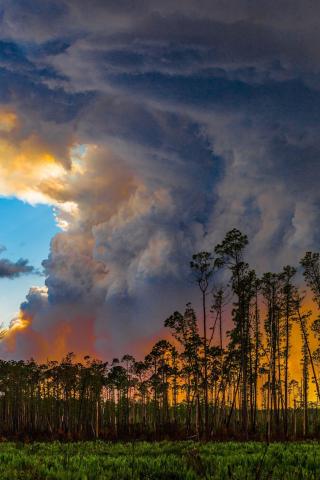Smoke from Wildfires Can Have Lasting Climate Impact
The wildfire that has raged across more than 150,000 acres of the Okefenokee Swamp in Georgia and Florida has sent smoke billowing into the sky as far as the eye can see. Now, new research published by the Georgia Institute of Technology shows how that smoke could impact the atmosphere and climate much more than previously thought.
Researchers have found that carbon particles released into the air from burning trees and other organic matter are much more likely than previously thought to travel to the upper levels of the atmosphere, where they can interfere with rays from the sun – sometimes cooling the air and at other times warming it.
“Most of the brown carbon released into the air stays in the lower atmosphere, but a fraction of it does get up into the upper atmosphere, where it has a disproportionately large effect on the planetary radiation balance – much stronger than if it was all at the surface,” said Rodney Weber, a professor in Georgia Tech’s School of Earth & Atmospheric Sciences.
The study, which was published May 22 in the journal Nature Geoscience, was sponsored by the NASA Radiation Sciences Program and the NASA Tropospheric Composition Program.
The researchers analyzed air samples collected in 2012 and 2013 by NASA aircraft from the upper troposphere – about seven miles above the earth’s surface – at locations across the United States. They found surprising levels of brown carbon in the samples but much less black carbon.
While black carbon can be seen in the dark smoke plumes rising above burning fossil or biomass fuels at high temperature, brown carbon is produced from the incomplete combustion that occurs when grasses, wood or other biological matter smolders, as is typical for wildfires. As particulate matter in the atmosphere, both can interfere with solar radiation by absorbing and scattering the sun’s rays.
The climate is more sensitive to those particulates as their altitude increases. The researchers found that brown carbon appears much more likely than black carbon to travel through the air to the higher levels of the atmosphere where it can have a greater impact on climate.
“People have always assumed that when you emit this brown carbon, over time it goes away,” said Athanasios Nenes, a professor and Georgia Power Scholar in the School of Earth & Atmospheric Sciences and the School of Chemical & Biomolecular Engineering.
After the brown carbon is carried by smoke plumes into the lower atmosphere, it mixes with clouds. Then it hitches a ride on the deep convection forces that exist in clouds to travel to the upper atmosphere.
Although the researchers couldn’t explain how, they also found that during the journey through the clouds, the brown carbon became more concentrated relative to black carbon.
“The surprise here is that the brown carbon gets promoted when you go through the cloud, compared to black carbon,” Nenes said. “This suggests that there may be in-cloud production of brown carbon that we were not aware of before.”
This material is based upon work supported by the NASA Radiation Sciences Program under grant No. NNX14AP74G and the NASA Tropospheric Composition Program under grant Nos. NNX12AB80G, NNX12AC03G and NNX15AT96G. Any opinions, findings, and conclusions or recommendations expressed in this material are those of the authors and do not necessarily reflect the views of NASA.
CITATION: Yuzhong Zhang, Haviland Forrister, Jiumeng Liu, Jack Dibb, Bruce Anderson, Joshua P. Schwarz, Anne E. Perring, Jose L. Jimenez, Pedro Campuzano-Jost, Yuhang Wang, Athanasios Nenes and Rodney J. Weber, “Top-of-atmosphere radiative forcing affected by brown carbon in the upper troposphere,” (Nature Geoscience, May 2017). http://dx.doi.org/10.1038/NGEO2960
Additional Images

